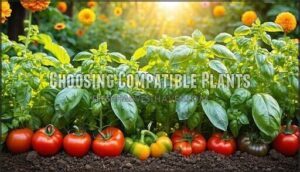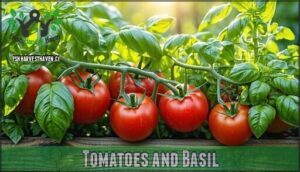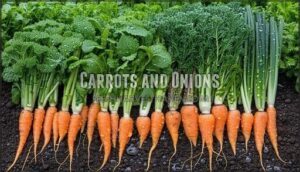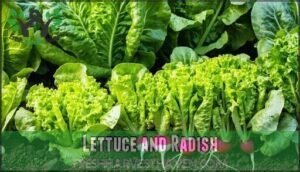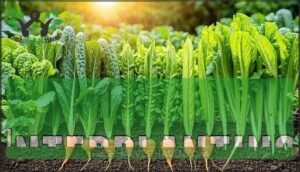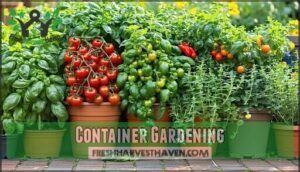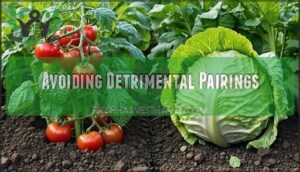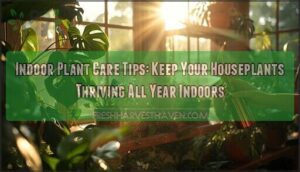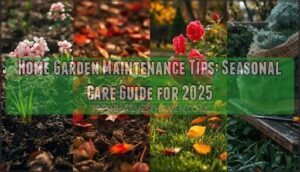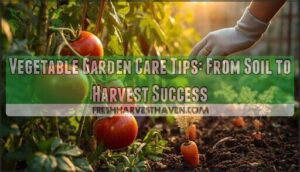This site is supported by our readers. We may earn a commission, at no cost to you, if you purchase through links.
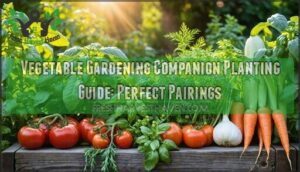 Your vegetable gardening companion planting guide starts with understanding how plants naturally support each other.
Your vegetable gardening companion planting guide starts with understanding how plants naturally support each other.
You’ll pair crops like tomatoes with basil for pest control, or plant carrots alongside onions to maximize space and soil nutrients.
This strategic approach reduces your need for pesticides while boosting yields through natural partnerships.
Some combinations fix nitrogen, others provide shade, and many deter harmful insects through their scents or root systems.
The key lies in matching complementary growth habits and timing your plantings correctly.
Master gardeners know that certain pairings can make or break your harvest success.
Table Of Contents
- Key Takeaways
- Companion Planting Basics
- Choosing Compatible Plants
- Beneficial Plant Pairings
- Planting Strategies
- Avoiding Detrimental Pairings
- Frequently Asked Questions (FAQs)
- Which vegetables grow well together chart?
- What veggies pair well together?
- What plants grow best together in a vegetable garden?
- What vegetables should not be planted next to each other in a garden?
- What vegetables go best together?
- What is vegetable companion planting?
- Why should you plan your vegetable garden out with companion plants?
- How do you choose plants for companion gardening?
- What is companion planting?
- What is a good companion plant?
- Conclusion
Key Takeaways
- You’ll maximize garden space and yields by pairing plants like tomatoes with basil, corn with beans, and carrots with onions—these proven combinations naturally repel pests while improving soil health.
- You can reduce your reliance on pesticides by using companion plants as natural pest deterrents, with marigolds repelling aphids and nasturtiums acting as trap crops for harmful insects.
- You’ll need to avoid problematic pairings like tomatoes with cabbage or beans with onions, as these combinations compete for nutrients and can reduce yields by up to 25%.
- You should plan your garden layout considering plant heights, growth rates, and nutrient needs—pairing shallow-rooted lettuce with deep-rooted tomatoes prevents competition while maximizing space efficiency.
Companion Planting Basics
You’ll discover that companion planting turns your garden into a naturally balanced ecosystem where plants work together to solve common problems.
Transform your backyard into nature’s perfectly orchestrated symphony where every plant plays its part.
This time-tested approach helps you maximize space, reduce pests, and boost harvests without relying on chemicals.
Benefits of Companion Planting
Companion planting benefits your vegetable garden through natural pest reduction and soil improvement.
You’ll attract pollinators while maximizing space efficiently. Plants work together, creating flavor enhancement in crops like tomatoes paired with basil.
This time-tested approach reduces chemical dependence, improves garden health, and boosts yields naturally through strategic plant partnerships, utilizing natural pest reduction and soil improvement.
Space Efficiency
Smart gardening means using every inch wisely.
Vertical gardening with pole beans climbing corn stalks maximizes height, while intercropping methods like tucking lettuce between slower-growing tomatoes uses ground space efficiently.
Container optimization and square foot gardening techniques help you fit more companion planting vegetables into small areas.
Succession planting keeps harvests flowing continuously.
Strategic garden planning and proper plant spacing create garden efficiency that’ll make neighbors jealous of your productive setup with vertical gardening.
Natural Pest Deterrent
Beyond maximizing space, companion planting creates your garden’s own security system.
Strategic plant partnerships naturally repel pests while attracting beneficial insects that patrol your crops.
This organic approach reduces your reliance on chemical sprays, letting nature handle pest control through clever plant combinations and natural deterrents.
- Trap cropping with nasturtiums draws aphids away from valuable vegetables
- Repellent herbs like basil and marigolds emit scents that confuse harmful insects
- Beneficial insects flock to companion flowers, creating a natural pest patrol
- Nematode control through marigolds protects root systems from microscopic invaders
Cut Down on Weeds
Dense planting with your companion planting vegetables creates natural weed suppression by shading soil and reducing available space.
Ground cover plants like sprawling squash or lettuce fill gaps between taller crops, acting as living mulch. This vegetable garden planting strategy maximizes space while crowding out unwanted weeds.
Your companion planting guide becomes more effective when plants work together for weed control, and by using companion planting you can create a more efficient garden.
Choosing Compatible Plants
Successfully choosing compatible plants requires understanding each vegetable’s specific needs for water, sunlight, and nutrients.
You’ll want to match plants with similar growing requirements while selecting varieties that offer complementary benefits like pest control or soil improvement.
Understanding Plant Needs
You’ll need to match plants with similar sunlight requirements, water needs, and soil composition preferences.
Check each plant’s nutrient uptake patterns and growth stages to avoid competition.
Understanding these plant needs helps you create partnerships where vegetables support rather than compete with each other for resources.
Complementary Growth Habits
When selecting plants for your vegetable companion planting guide, you’ll want companions that work together like puzzle pieces.
Different growth patterns create natural partnerships that maximize your garden’s potential.
- Root Depths: Shallow-rooted lettuce pairs perfectly with deep-rooted tomatoes, preventing competition for nutrients
- Vertical Gardening: Tall corn supports climbing beans while short carrots grow beneath
- Sunlight Needs: Sun-loving peppers can shade heat-sensitive spinach during hot afternoons
Understanding how plant compatibility affects nutrient uptake and water requirements helps you create thriving combinations.
Companion planting can also provide natural pest control by repelling unwanted insects.
Researching Compatible Pairs
After understanding plant needs, you’ll want to research which pairings actually work together.
Don’t rely on folklore alone—look for scientific validation and evidence-based research from universities and extension offices.
Online resources like companion planting guides provide tested combinations, while expert opinions help separate myth from reality.
| Plant Combination | Scientific Evidence | Trial Results |
|---|---|---|
| Tomatoes + Basil | Reduces thrips by 40% | 20% yield increase |
| Corn + Beans | Nitrogen fixation proven | Enhanced growth rates |
| Carrots + Onions | Repels carrot rust fly | Fewer pest issues |
| Marigolds + Vegetables | Limonene deters aphids | Reduced whitefly damage |
| Nasturtiums + Cucumbers | Trap crop effectiveness | Lower aphid populations |
Remember, even expert-backed vegetable companion planting requires trial and error in your specific conditions.
Plant Height Considerations
Three key factors shape successful companion planting: sunlight access, shading effects, and air circulation.
**Smart plant partnerships unlock your garden’s hidden potential through natural teamwork.
You’ll maximize garden space through vertical gardening with support structures, letting taller plants like corn shelter shorter plants beneath.
Smart interspersing creates natural microclimates – tall garden companion plants provide afternoon shade for heat-sensitive crops while ensuring proper air circulation between plant heights, which is crucial for creating a healthy microclimate.
Beneficial Plant Pairings
You’ll find these proven plant partnerships transform your garden into a productive ecosystem where each crop helps its neighbors thrive.
These time-tested combinations work together to repel pests, improve soil health, and maximize your harvest space.
Corn and Beans
Why does this classic American Indian gardening technique work so brilliantly? Corn and beans create the perfect partnership through nitrogen fixation and natural support systems.
These climbing beans use corn stalks as living trellises while enriching soil for heavy-feeding corn. You can find nitrogen fixing bean seeds for your garden.
- Beans fix nitrogen – naturally fertilizing corn’s hungry roots
- Corn provides structure – eliminating need for bean poles or stakes
- Space efficiency increases – maximizing garden productivity by 30%
- Pest confusion occurs – mixed scents deter corn borers and earworms
Tomatoes and Basil
Moving from beans’ nitrogen gifts to leafy partners, basil and tomatoes create gardening’s most celebrated friendship.
You’ll boost tomato yields by 10-15% while basil’s aromatic oils repel thrips and whiteflies naturally.
This classic companion planting duo delivers enhanced flavor enhancement through chemical synergy, with basil varieties like Genovese amplifying tomato sweetness.
For grilled salads, consider basil and tomatoes as a delightful pairing, and their growth synergy maximizes space efficiently, making this pairing perfect for vegetable gardening success.
Carrots and Onions
Carrots and onions create a powerful pest deterrence partnership that’ll transform your garden.
These carrot companions and onion companions work together through scent masking—onions repel carrot flies while carrots confuse onion maggots.
This companion planting duo also promotes growth synergy by utilizing different soil depths, enhancing soil health and providing natural flavor enhancement for both crops.
You can find many carrot onion products online.
Lettuce and Radish
You’ll love how lettuce and radish work together in companion planting. These garden vegetables have complementary growth rates—radish matures quickly while lettuce develops slowly, maximizing space efficiency.
Their different soil preferences and root depths prevent competition. Radish naturally provides pest control for lettuce, while both vegetables maintain distinct flavor profiles.
Strategic harvest timing allows continuous production throughout your growing season.
Planting Strategies
You’ll need smart planting strategies to maximize your companion planting success and create a thriving garden ecosystem.
These techniques help you organize your space efficiently while ensuring each plant gets what it needs to flourish alongside its companions, using complete concepts to achieve this goal.
Crop Rotation
Understanding crop rotation prevents your vegetable garden from becoming a pest paradise.
You’ll break harmful pest cycles and disease buildup by moving plant families to different garden spots each season.
This rotation planning maintains soil fertility since different vegetables consume varying nutrients.
Your soil health improves dramatically when you rotate heavy feeders like tomatoes with nitrogen-fixing beans, creating natural nutrient management that keeps your garden thriving year after year with complete concepts.
Interplanting
After setting up your crop rotation schedule, you can maximize garden space through strategic interplanting techniques.
Succession planting lettuce every two weeks keeps harvests coming, while vertical gardening with pole beans climbing corn creates natural trellises.
Plant fast-growing radishes between slower carrots for efficient ground cover, and try nurse cropping by pairing delicate seedlings with hardier companions that provide protection and shade.
Container Gardening
Container gardening transforms small spaces into productive vegetable gardens using strategic companion planting. Choose containers with proper drainage and appropriate sizes—tomatoes need 5-gallon pots while herbs thrive in smaller ones.
Layer vertical gardening techniques by pairing tall plants with compact companions. Match watering needs between paired plants, as containers dry faster than garden beds.
Select potting mixes designed for vegetables, ensuring adequate sunlight exposure for your chosen combinations. Consider that drainage holes are essential to prevent waterlogged roots, which is crucial for the health of the plants.
Garden Planning
With clever layout design and sunlight analysis, you’ll create a garden planning guide that maximizes space and yields.
Map companion planting combinations on a companion planting chart, noting resource allocation for each bed.
Succession planting extends harvests throughout the season.
A detailed guide assists in garden preparation.
Garden journaling tracks what works best in your vegetable gardening adventures, helping you refine companion planting strategies year after year.
Avoiding Detrimental Pairings
Just as some plants thrive together, others can harm each other’s growth and health when planted too close.
You’ll want to avoid these problematic pairings to prevent stunted growth, reduced yields, and increased pest problems in your vegetable garden.
Plants to Avoid Together
While strategic garden planning helps you maximize space, some plant combinations can backfire.
Tomatoes and cabbage create growth inhibition through allelopathic effects, reducing yields by 25%. Beans and onions suffer from nutrient competition and poor companion plant relationships.
Fennel acts as a troublesome neighbor, causing resource depletion in most vegetables through plant competition for water, sunlight, and nutrients. Consider also plant height considerations to avoid shading issues.
Common Mistakes
Beyond knowing which plants don’t mix well, you’ll want to sidestep these companion planting pitfalls that can torpedo your vegetable gardening efforts.
Poor soil preparation and ignoring needs often cause more problems than Wrong Timing or Lack Research alone.
- Ignoring Needs: Pairing sun-loving tomatoes with shade-preferring lettuce creates stressed, underperforming plants
- Overcrowding Plants: Cramming too many companions together invites garden pests and plant diseases to spread rapidly
- Poor Soil: Skipping soil testing means you can’t address nutrient deficiencies that affect plant compatibility
- Lack Research: Planting based on gardening tips from unreliable sources leads to failed partnerships
- Wrong Timing: Starting cool-season crops alongside warm-season vegetables creates growth mismatches
Soil Fertility Considerations
Understanding which plants drain your soil’s nutrient supply helps prevent stunted growth and poor harvests.
Heavy feeders like corn and tomatoes can deplete nitrogen levels, while legumes actually improve soil fertility through nitrogen fixation.
You’ll want to balance nutrient-hungry crops with plants that contribute to soil microbes and organic matter through green manure or cover cropping strategies.
Frequently Asked Questions (FAQs)
Which vegetables grow well together chart?
You’ll find success pairing tomatoes with basil, corn with beans, and carrots with onions. These classic combinations repel pests, improve growth, and maximize your garden’s potential naturally.
What veggies pair well together?
You’ll get great results pairing tomatoes with basil, corn with beans and squash, and carrots with onions. These classic combinations naturally repel pests while boosting flavors and yields.
What plants grow best together in a vegetable garden?
Tomatoes thrive with basil, onions enhance carrots, and beans fix nitrogen for corn.
You’ll maximize yields by pairing marigolds with peppers, planting nasturtiums near cucumbers, and growing lettuce beneath tall plants.
What vegetables should not be planted next to each other in a garden?
Avoid planting tomatoes near cabbage and beets, peppers near beans and brassicas, cucumbers near sage, and onions near asparagus. These combinations compete for nutrients or inhibit growth.
What vegetables go best together?
Picture Maria’s thriving garden where her tomato plants tower over basil companions.
You’ll find success pairing tomatoes with basil, corn with beans, and carrots with chives—these partnerships naturally repel pests while boosting flavor and growth through complementary root systems and natural compounds, with complete concepts like these being particularly effective.
The idea is to utilize natural compounds to enhance the garden’s overall health.
What is vegetable companion planting?
Companion planting strategically pairs different vegetables and herbs together in your garden, creating natural partnerships that boost growth, repel pests, and improve soil health through beneficial plant interactions.
Why should you plan your vegetable garden out with companion plants?
Think of your garden as nature’s chess board—strategic plant placement creates winning combinations.
You’ll boost yields, reduce pests naturally, improve soil health, and maximize space efficiency.
Companion planting transforms scattered vegetables into a thriving ecosystem that practically grows itself, creating winning combinations and a thriving ecosystem.
How do you choose plants for companion gardening?
You’ll want to research proven combinations like tomatoes with basil or marigolds with vegetables. Consider your garden’s specific needs, spacing requirements, and choose plants that deter your common pests effectively.
What is companion planting?
Discovering nature’s ultimate gardening hack, you’ll plant different species together where each one helps the other thrive through natural pest control, improved soil health, and enhanced growth rates.
What is a good companion plant?
Marigolds make excellent companions because they’ll repel aphids and whiteflies while attracting beneficial insects to your garden.
You can’t go wrong planting them near tomatoes, peppers, or cucumbers for natural pest control.
Conclusion
Creating the perfect garden resembles conducting an orchestra—each plant plays its part in nature’s symphony.
Your vegetable gardening companion planting guide success depends on understanding these plant relationships and implementing them strategically.
You’ll discover that thoughtful pairings reduce pest problems, maximize yields, and improve soil health naturally.
Start with proven combinations like tomatoes with basil or corn with beans, then expand your knowledge through observation and experimentation.
With proper planning and patience, companion planting transforms your garden into a thriving, self-sustaining ecosystem that produces abundant harvests year after year, utilizing companion planting to achieve a balanced and self-sustaining environment.

